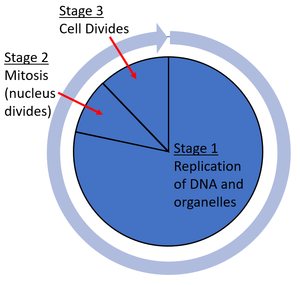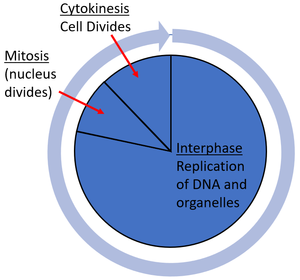Difference between revisions of "Cell Cycle"
| (One intermediate revision by the same user not shown) | |||
| Line 27: | Line 27: | ||
:[https://www.amazon.co.uk/gp/product/1471851354/ref=as_li_tl?ie=UTF8&camp=1634&creative=6738&creativeASIN=1471851354&linkCode=as2&tag=nrjc-21&linkId=9012a0d354024419214fb3ad5ac44ba0 ''Cell cycle, page 21, GCSE Combined Science Trilogy 1, Hodder, AQA ''] | :[https://www.amazon.co.uk/gp/product/1471851354/ref=as_li_tl?ie=UTF8&camp=1634&creative=6738&creativeASIN=1471851354&linkCode=as2&tag=nrjc-21&linkId=9012a0d354024419214fb3ad5ac44ba0 ''Cell cycle, page 21, GCSE Combined Science Trilogy 1, Hodder, AQA ''] | ||
:[https://www.amazon.co.uk/gp/product/0198359373/ref=as_li_tl?ie=UTF8&camp=1634&creative=6738&creativeASIN=0198359373&linkCode=as2&tag=nrjc-21&linkId=952a73bbb09d222ecc4b50d200679849 ''Cell cycle, pages 26-27, GCSE Biology; Third Edition, Oxford University Press, AQA ''] | :[https://www.amazon.co.uk/gp/product/0198359373/ref=as_li_tl?ie=UTF8&camp=1634&creative=6738&creativeASIN=0198359373&linkCode=as2&tag=nrjc-21&linkId=952a73bbb09d222ecc4b50d200679849 ''Cell cycle, pages 26-27, GCSE Biology; Third Edition, Oxford University Press, AQA ''] | ||
| + | |||
| + | ====Edexcel==== | ||
| + | |||
| + | :[https://www.amazon.co.uk/gp/product/1292120193/ref=as_li_tl?ie=UTF8&camp=1634&creative=6738&creativeASIN=1292120193&linkCode=as2&tag=nrjc-21&linkId=572df39392fb4200db8391d98ae6314e ''Cell cycle, page 26, GCSE Combined Science, Pearson Edexcel ''] | ||
| + | :[https://www.amazon.co.uk/gp/product/1292120207/ref=as_li_tl?ie=UTF8&camp=1634&creative=6738&creativeASIN=1292120207&linkCode=as2&tag=nrjc-21&linkId=22455ff53961978667722edaa64c0be5 ''Cell cycle, page 30, GCSE Biology, Pearson, Edexcel ''] | ||
| + | |||
| + | ====OCR==== | ||
| + | :[https://www.amazon.co.uk/gp/product/1782945695/ref=as_li_tl?ie=UTF8&camp=1634&creative=6738&creativeASIN=1782945695&linkCode=as2&tag=nrjc-21&linkId=ceafcc80bcad6b6754ee97a0c7ceea53 ''Cell cycle, page 23, Gateway GCSE Combined Science; The Revision Guide, CGP, OCR ''] | ||
| + | :[https://www.amazon.co.uk/gp/product/1782945660/ref=as_li_tl?ie=UTF8&camp=1634&creative=6738&creativeASIN=1782945660&linkCode=as2&tag=nrjc-21&linkId=83aa4500ad7759e7f401a1c5ba5df758 ''Cell cycle, page 28, Gateway GCSE Biology; The Revision Guide, CGP, OCR ''] | ||
Latest revision as of 12:16, 1 December 2019
Contents
Key Stage 4 Foundation
Meaning
The Cell Cycle is the process of growth and division that leads to to the formation of new cells.
About the Cell Cycle
The Cell Cycle consists of 3 stages:
- Stage 1 - The cell grows, the DNA is made into two copies and more organelles are made.
- Stage 2 - Mitosis in which the nucleus divides inside the cell.
- Stage 3 - The cell splits into two identical daughter cells.
Key Stage 4 Higher
Meaning
The Cell Cycle is the process of growth and division that leads to to the formation of new cells.
About the Cell Cycle
The Cell Cycle consists of 3 stages:
- Interphase - The first stage in which the cell grows, the DNA is made into two copies and more organelles are made.
- Mitosis - The second stage in which the nucleus divides inside the cell.
- Cytokinesis - The final stage in which the cell splits into two identical daughter cells.
References
AQA
- Cell cycle, page 21, GCSE Biology, Hodder, AQA
- Cell cycle, page 21, GCSE Combined Science Trilogy 1, Hodder, AQA
- Cell cycle, pages 26-27, GCSE Biology; Third Edition, Oxford University Press, AQA
Edexcel
- Cell cycle, page 26, GCSE Combined Science, Pearson Edexcel
- Cell cycle, page 30, GCSE Biology, Pearson, Edexcel

